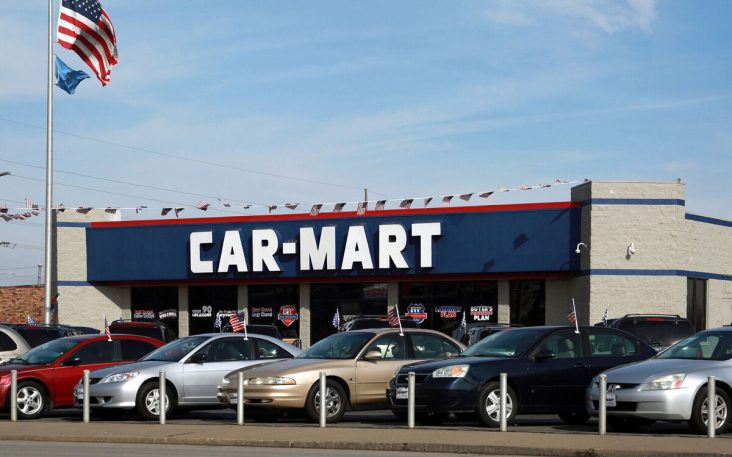Car-Mart earnings to decline, revenue to rise in third-quarter fiscal 2023
by February 14, 2023 2:04 pm 926 views

Rogers-based America’s Car-Mart Inc. is expected to post a double-digit earnings decline and revenue growth in the third quarter of fiscal 2023 amid mixed prices and sales in the used vehicle industry.
Before the markets open on Feb. 22, Car-Mart is expected to report earnings for the quarter ending Jan. 31 fell to 49 cents per share, from $2.77 per share, based on a consensus of three analysts. Revenue is projected to rise by 11.8% to $326.36 million from $291.9 million.
In an earnings preview, equity analysts John Hecht and Kyle Joseph and equity associates Matthew Hurwit, Sagiv Hartmayer, Alexander Villalobos and Ibrahim Kargbo, all of Jefferies LLC, attributed the revenue rise to an 11% sales increase and interest income of 28%. They expect gross profit margin to fall by 5.81 percentage points to 29% in the quarter from the same period last year.
Regarding credit, third-quarter loss rates are expected to rise by 12 percentage points from last year’s period. As a result, provision expenses are projected to increase by 22% to $82 million. Total expenses are expected to rise by 22% to $326 million.
“Credit trends have normalized to pre-pandemic levels on a frequency basis but have not translated to serious (delinquency) status yet,” the analysts said. “We could see incremental pressure on the severity side of the equation as used car prices continue to abate.”
Third-quarter vehicle sales are expected to rise by 3% to 14,600 vehicles. Average retail sales are expected to increase by 7.5% to about $18,400. The analysts noted that “pricing has begun to show signs of abating.” Price increases peaked in the third quarter of fiscal 2022 at a rate of nearly 25% and have since slowed in the following quarters.
“Moving forward, we anticipate price increases to slow and eventually flatten out as demand for autos continues to weaken,” the analysts said. “Despite a challenging autos market, (Car-Mart) remains well positioned competitively as credit tightening higher up in the customer-quality funnel is enabling higher credit quality consumers to drop down into (Car-Mart’s) bucket.
“We believe the current state of [the] autos market underscores (Car-Mart’s) value proposition as an affordable used car dealer. We anticipate market share gains through both organic and inorganic means as customers above (Car-Mart’s) typical credit box flow to the company’s lots and more thinly capitalized, private dealers put themselves on the auction block.” The analysts noted the December acquisition of Taylor Auto Credit will allow the company to expand in Texas.
According to the analysts, Car-Mart recently renewed its “focus on optimizing expenses through near-term investments in procurement initiatives. We see some offsetting influences on (Car-Mart) in the near term, including used car prices leveling off, which has offsetting impacts on the business, and a tighter credit environment, which should support sales. Top-line comps will be tough entering the new fiscal year on slowing prices; however, a growing consumer base and potential for gross margin recovery may provide some offset.”
Jefferies analysts maintained a hold rating for Car-Mart stock and increased the 12-month target price by 14% to $75. The analysts noted, “this is a discount to historical levels given macro pressures.”
Shares of Car-Mart (NASDAQ: CRMT) closed Monday (Feb. 13) at $91.93 and were trading Tuesday (Feb. 14) at $91.58, down 35 cents or 0.38%. In the past 52 weeks, the stock has ranged between $52.24 and $127.05.
BROADER TRENDS
In January, the Manheim Used Vehicle Value Index rose by 2.5% from December. The index, which shows price changes on the wholesale market, indicated “stronger-than-usual values and demand at wholesale,” according to Cox Automotive. This was a surprise because January is typically slow for the automotive business.
Cox Automotive partly attributed the rise to stronger-than-expected retail used-vehicle sales, which were supported by softening retail prices. Used vehicle dealers returned to the wholesale market to replenish inventories, increasing wholesale values.
“The principal reason for improving used retail sales early in 2023 is the price decline in retail that was a product of last fall’s wholesale price declines,” said Jonathan Smoke, chief economist for Cox Automotive. “Now dealers are restocking at higher prices, so the retail price trend will reverse soon. Maintaining positive sales momentum with higher prices will be tough, especially as rates keep rising.”
Between 2021 and 2022, the average new vehicle loan rose by 10.4% to $41,700, according to Jefferies analysts. Over the same period, the average used vehicle loan increased by 8.6% to $28,500.
Meanwhile, average loan payments for new vehicles rose from $618 to $700 per month. For used vehicles, the average loan payments increased from $472 to $525 monthly.
“This upward pressure comes with two factors worth monitoring: lower unit volumes tied to unaffordability and the impact on credit risk over the longer term from higher monthly debt servicing,” the Jefferies analysts said. “Inflation and tightening credit conditions will exacerbate this risk as higher non-discretionary costs crowd out some borrowers’ ability to service debt while lower access to capital impacts liquidity overall.”
